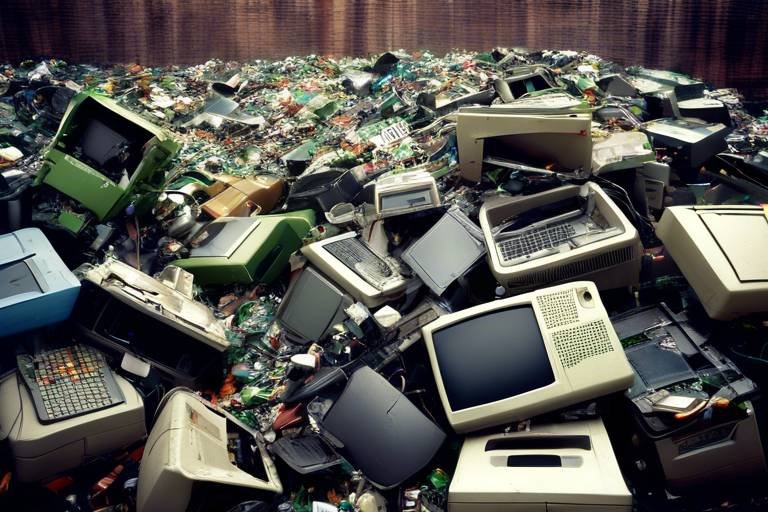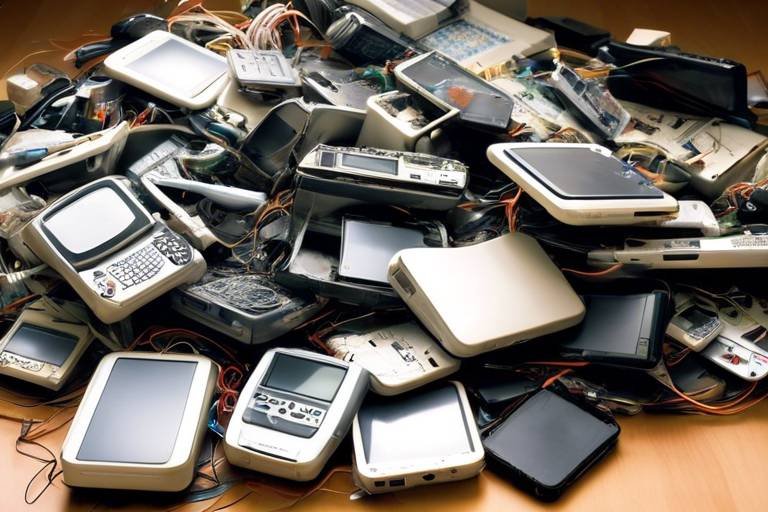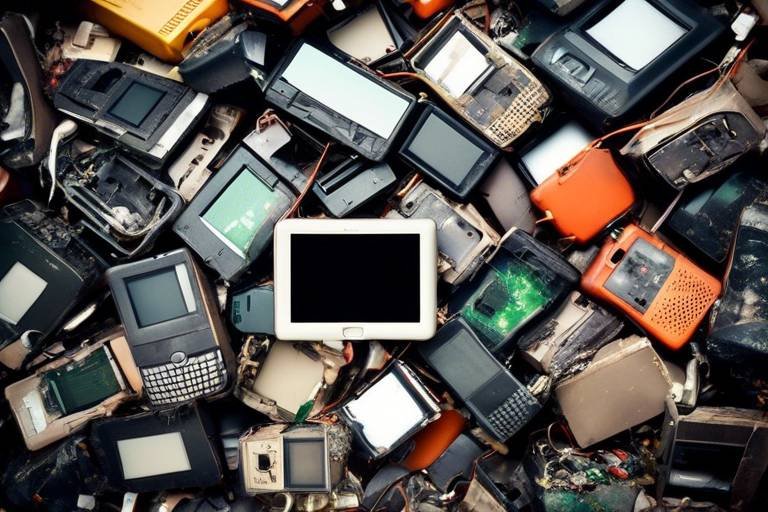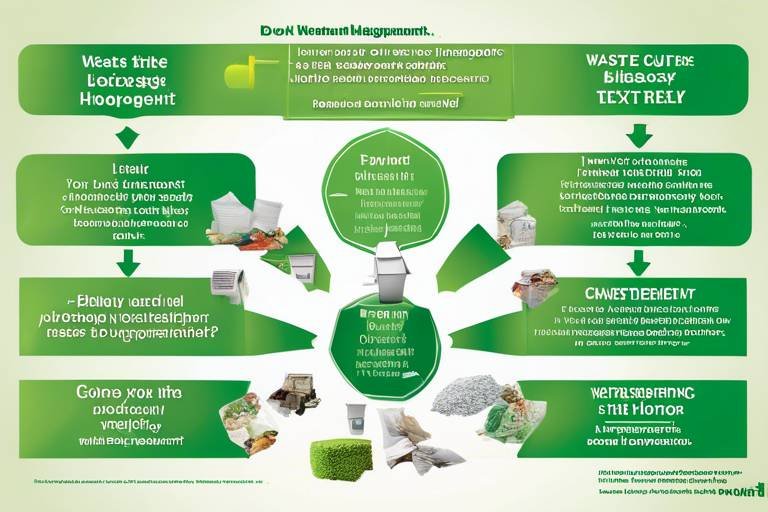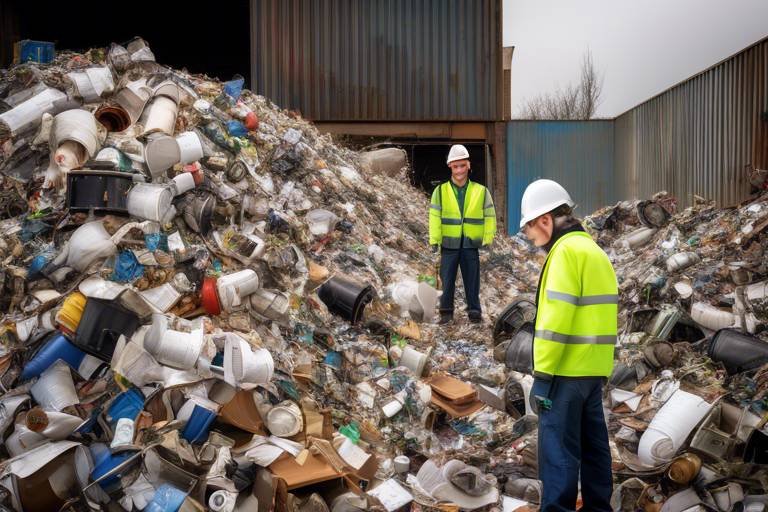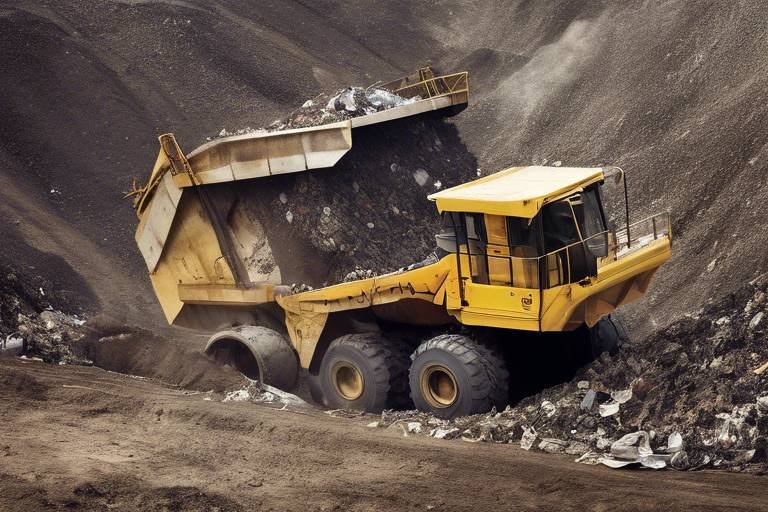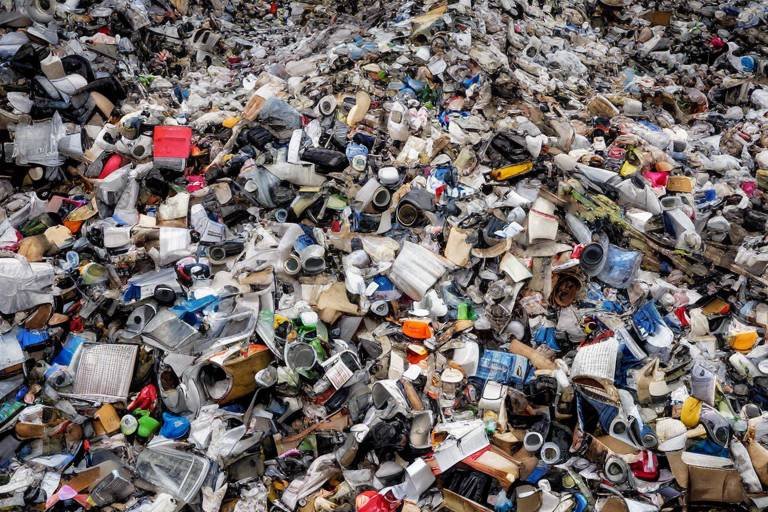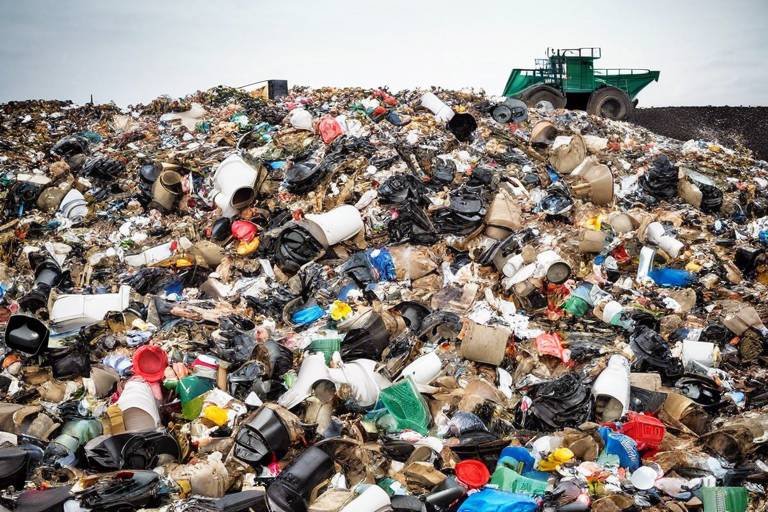The Role of Digitalization in Waste Management
In today's fast-paced world, the intersection of technology and environmental stewardship is more crucial than ever. Digitalization in waste management is not just a buzzword; it's a game-changer that is reshaping how we think about waste disposal and recycling. Imagine a world where garbage collection is as efficient as online shopping delivery—where data drives decisions, and communities actively engage in sustainability efforts. This innovative approach is enhancing efficiency, sustainability, and community engagement in waste disposal and recycling processes.
Digital technologies, such as the Internet of Things (IoT), artificial intelligence (AI), and big data analytics, are revolutionizing traditional waste management practices. By integrating these technologies, waste management companies can improve their operations significantly. For instance, smart bins equipped with sensors can notify collection services when they are full, ensuring timely pickups and reducing overflow issues. This not only optimizes collection routes but also minimizes the environmental impact associated with unnecessary trips.
Moreover, digitalization allows for better tracking of waste streams, enabling companies to identify patterns and make informed decisions. This data-driven approach leads to enhanced recycling rates as companies can pinpoint areas where recycling efforts may be lacking. By understanding waste generation trends, organizations can implement targeted initiatives that resonate with community needs, fostering a culture of recycling and responsible waste disposal.
As we delve deeper into the benefits of digital waste management solutions, it becomes clear that the advantages extend beyond operational efficiency. These innovations contribute to significant cost savings and improved regulatory compliance, paving the way for a more sustainable future. Communities are not just passive observers; they are becoming active participants in the waste management process, thanks to digital platforms that facilitate engagement and communication.
In conclusion, digitalization is playing a pivotal role in transforming waste management practices. It enhances operational efficiency, promotes sustainability, and encourages community involvement. As we embrace these changes, we take a significant step towards a cleaner, greener planet.
- What is digitalization in waste management? Digitalization in waste management refers to the integration of digital technologies into waste management systems, improving data collection, analysis, and operational efficiency.
- What are the benefits of digital waste management solutions? Benefits include cost savings, enhanced recycling rates, improved tracking of waste streams, and better compliance with environmental regulations.
- How does real-time monitoring work? Real-time monitoring systems use sensors to track waste levels and collection schedules, optimizing routes and ensuring timely pickups.
- What challenges are associated with implementing digital solutions? Challenges include high initial costs, technological barriers, and the need for effective training and change management.

Understanding Digitalization in Waste Management
Digitalization is transforming the way we approach waste management, and it's about time we dive into what this really means. Imagine a world where data drives decisions, where waste isn't just discarded but is seen as a valuable resource. That's the essence of digitalization in waste management. It refers to the integration of digital technologies into traditional waste management systems, and it’s not just a trend; it’s a necessity in our rapidly changing environment.
At its core, digitalization enhances the efficiency of waste management practices through improved data collection and analysis. By employing advanced technologies such as the Internet of Things (IoT), artificial intelligence (AI), and big data analytics, waste management companies can monitor, manage, and optimize their operations like never before. This leads to better decision-making and ultimately a reduction in environmental impact. Think of it as upgrading from a flip phone to a smartphone; the capabilities expand exponentially, and so do the benefits.
For instance, consider how waste is typically collected. In traditional systems, collection schedules might be based on estimates or historical data, which can lead to either over-scheduling or under-scheduling pickups. With digital tools, waste management companies can utilize real-time data to understand exactly when bins are full and need to be emptied. This not only saves time and resources but also reduces the carbon footprint associated with unnecessary trips. In essence, digitalization turns waste management into a dynamic, responsive system rather than a static one.
Moreover, digitalization fosters a culture of sustainability. By providing insights into waste generation patterns, companies can identify opportunities for recycling and waste reduction. For example, if a business notices a spike in plastic waste, they can take proactive steps to reduce it, such as implementing a recycling program or switching to more sustainable materials. This level of awareness and responsiveness is crucial for creating a circular economy where waste is minimized and resources are reused.
In addition to enhancing operational efficiency and sustainability, digitalization also plays a pivotal role in engaging the community. Through mobile apps and online platforms, residents can report issues, access information about recycling programs, and even track their waste disposal habits. This engagement fosters a sense of responsibility and collaboration among community members, turning waste management into a shared mission rather than a burden.
In summary, understanding digitalization in waste management is about recognizing its potential to revolutionize how we handle waste. By integrating digital technologies, we can improve efficiency, promote sustainability, and encourage community engagement. It’s a win-win for everyone involved, paving the way for a cleaner, greener future.

Benefits of Digital Waste Management Solutions
Digital waste management solutions are revolutionizing the way we approach waste disposal and recycling. By harnessing the power of technology, these solutions not only streamline operations but also promote sustainability and community involvement. Imagine a world where waste is managed efficiently, resources are conserved, and communities are engaged in the process. This is not just a dream; it’s becoming a reality thanks to digitalization.
One of the most significant advantages of digital waste management is the potential for cost savings. Traditional waste management methods often involve inefficiencies that lead to increased operational costs. However, with digital tools, companies can optimize their processes, leading to significant reductions in expenses. For instance, by utilizing real-time data on waste collection and disposal, companies can minimize fuel costs by optimizing collection routes. This not only saves money but also reduces the carbon footprint associated with waste collection.
Moreover, digital solutions enhance the tracking of waste streams. With advanced tracking systems, waste management companies can monitor the flow of waste from its source to its final destination. This transparency is crucial for ensuring that waste is disposed of properly and that recyclable materials are diverted from landfills. Enhanced tracking also aids in compliance with environmental regulations, as companies can easily demonstrate their adherence to waste management standards.
Another compelling benefit is the improvement in recycling rates. Digital platforms can provide residents with information on recycling practices and schedules, making it easier for them to participate. For example, mobile apps can alert users about recycling days and provide tips on what materials can be recycled. As communities become more informed, recycling rates tend to increase, leading to a more sustainable approach to waste management.
Additionally, digital waste management solutions facilitate better compliance with regulations. Waste management is heavily regulated to protect the environment, and failing to comply can result in hefty fines. Digital solutions can automate compliance monitoring, ensuring that companies meet all necessary requirements without the need for extensive manual oversight. This automation not only saves time but also minimizes the risk of human error, which can lead to compliance issues.
To further illustrate the benefits of digital waste management, consider the following table:
| Benefit | Description |
|---|---|
| Cost Savings | Reduction in operational costs through optimized routes and processes. |
| Improved Tracking | Enhanced visibility of waste streams for better management and compliance. |
| Increased Recycling Rates | Higher community participation in recycling through accessible information. |
| Regulatory Compliance | Automated monitoring to ensure adherence to environmental laws. |
In conclusion, the benefits of digital waste management solutions are profound and far-reaching. They not only enhance operational efficiency but also foster a culture of sustainability and community responsibility. As we continue to embrace digitalization, the future of waste management looks promising, paving the way for a cleaner, greener planet.
- What are digital waste management solutions? Digital waste management solutions integrate technology into waste management processes to enhance efficiency, tracking, and community engagement.
- How do these solutions save costs? By optimizing collection routes and automating processes, companies can significantly reduce operational expenses.
- Can digital solutions improve recycling rates? Yes, they provide information and reminders to residents, encouraging participation in recycling programs.
- What challenges exist in implementing these solutions? Challenges include initial costs, technological barriers, and the need for staff training.

Enhanced Data Collection
In the rapidly evolving world of waste management, is a game changer. Imagine a scenario where waste management companies can gather real-time data on waste generation, disposal patterns, and recycling rates with just a few clicks. This is no longer a dream; it's a reality brought to life by digital technologies. By leveraging tools such as IoT sensors, mobile applications, and cloud computing, these companies can now collect vast amounts of data that were previously difficult to access.
For instance, with the installation of smart bins equipped with sensors, waste management services can monitor the fill levels of bins in real time. This means no more overflowing trash cans or unnecessary collection trips. Instead, the data collected allows for optimized collection routes, ensuring that waste is picked up only when necessary. This not only saves time and fuel but also significantly reduces operational costs. The ability to analyze this data leads to informed decision-making, ultimately enhancing the efficiency of waste management practices.
Moreover, enhanced data collection facilitates better tracking of waste streams. Companies can analyze the types and quantities of waste being generated, which is crucial for developing effective recycling strategies. For example, if data indicates a significant increase in plastic waste in a particular area, targeted recycling initiatives can be implemented to address this issue. This proactive approach not only improves recycling rates but also fosters a more sustainable environment.
Additionally, the integration of data analytics allows waste management companies to identify trends over time. By understanding seasonal variations in waste generation, they can adjust their operations accordingly. This could mean increasing collection frequency during peak seasons or launching educational campaigns to encourage recycling during specific times of the year. The insights gained from data analysis empower organizations to make strategic decisions that align with their sustainability goals.
To sum it up, enhanced data collection is not just about gathering numbers; it's about transforming those numbers into actionable insights. The benefits are clear:
- Improved operational efficiency through optimized routes and schedules.
- Increased recycling rates by identifying waste generation patterns.
- Cost savings from reduced fuel consumption and labor costs.
In a nutshell, the evolution of data collection in waste management is paving the way for a more efficient and sustainable future, making it an essential component of modern waste management practices.
Q1: What technologies are used for enhanced data collection in waste management?
A: Technologies such as IoT sensors, mobile apps, and cloud computing are commonly used to collect and analyze data in waste management.
Q2: How does real-time data collection improve waste management?
A: Real-time data collection allows for optimized collection routes, timely pickups, and better tracking of waste streams, leading to increased efficiency and reduced operational costs.
Q3: What are the benefits of analyzing waste generation trends?
A: Analyzing waste generation trends helps in making informed decisions regarding resource allocation, improving recycling initiatives, and enhancing overall service delivery.

Real-time Monitoring
In the fast-paced world we live in, where time is money, has emerged as a game changer in the waste management sector. Imagine a system that allows waste managers to have a bird's-eye view of their operations at any given moment. This isn't just a fancy idea; it's a reality brought to life by digital technologies. With real-time monitoring, waste managers can track waste levels in bins, monitor collection schedules, and even optimize routes for waste collection trucks. It's like having a GPS for garbage! By using sensors and IoT (Internet of Things) devices, waste management companies can receive instant updates on the status of waste containers, which significantly reduces the chances of overflow and the associated environmental hazards.
But how does this technology actually work? Well, it all starts with data collection. Smart bins equipped with sensors can detect when they are nearing capacity. This information is sent to a central management system, which processes the data and alerts waste collection teams about the need for a pickup. This not only ensures that bins are emptied before they overflow, but it also helps in planning collection routes more efficiently. Instead of following a fixed schedule, trucks can be dispatched based on real-time data, significantly reducing fuel consumption and operational costs. It's a win-win situation!
Moreover, real-time monitoring can enhance transparency and accountability in waste management. Residents can be informed about when their waste will be collected, and they can even track the collection vehicles in real-time. This fosters a sense of community engagement, as people feel more connected to the services being provided. It also encourages responsible waste disposal practices, as individuals are more likely to adhere to guidelines when they know their actions are being monitored.
To illustrate the impact of real-time monitoring, consider the following table that outlines the key benefits:
| Benefit | Description |
|---|---|
| Optimized Collection Routes | Minimizes fuel consumption and time spent on the road, leading to cost savings. |
| Reduced Overflow | Prevents bins from overflowing, which can cause environmental hazards and unpleasant odors. |
| Increased Efficiency | Enables waste collection teams to focus on high-priority areas, improving overall service delivery. |
| Enhanced Community Engagement | Residents can track collection schedules and participate in waste management initiatives. |
In conclusion, real-time monitoring is not just a technological advancement; it's a revolutionary approach that enhances the efficiency and sustainability of waste management practices. By leveraging real-time data, waste management companies can make informed decisions that not only benefit their operations but also contribute to a cleaner environment. As we continue to embrace digitalization, the future of waste management looks brighter than ever!
- What is real-time monitoring in waste management?
Real-time monitoring involves using digital technologies to track waste levels and collection schedules instantly, allowing for efficient waste management.
- How does real-time monitoring benefit the environment?
By preventing overflow and optimizing collection routes, real-time monitoring reduces environmental hazards and enhances sustainability.
- Can residents engage with waste management through real-time monitoring?
Yes! Real-time monitoring allows residents to track collection schedules and participate in community recycling initiatives.

Predictive Analytics
Predictive analytics is revolutionizing the way waste management companies operate, transforming raw data into actionable insights. Imagine trying to navigate a bustling city without a map—chaotic, right? Well, that’s how waste management used to function before the advent of predictive analytics. By utilizing sophisticated algorithms and historical data, waste management services can now forecast waste generation patterns with remarkable accuracy. This means they can anticipate how much waste will be produced in specific areas and at certain times, allowing for better planning and resource allocation.
For instance, if a neighborhood typically produces more waste during the holiday season, predictive analytics can alert waste management teams to increase collection frequency during these peak times. This not only enhances operational efficiency but also improves service delivery to the community. By ensuring timely pickups, companies can minimize overflow issues, which can lead to unsightly litter and potential health hazards.
Moreover, predictive analytics can help in identifying trends over time. For instance, if there’s a consistent increase in recyclable materials in a particular district, waste management companies can ramp up their recycling initiatives in that area. This not only promotes sustainability but also fosters a culture of recycling within the community. The enhanced data helps in crafting targeted campaigns that encourage residents to participate actively in recycling programs.
Additionally, the integration of predictive analytics can lead to significant cost savings. By optimizing routes based on anticipated waste volumes, companies can reduce fuel consumption and labor costs. This is akin to a seasoned chef who knows exactly how much of each ingredient to prepare based on the number of diners expected—no waste, no excess, just efficient service.
In conclusion, predictive analytics is not just a buzzword; it’s a game-changer in the waste management sector. By leveraging data to forecast demand, companies can enhance their operational efficiency, improve community engagement, and contribute to a more sustainable future. As we look ahead, embracing these technologies will be crucial for waste management companies aiming to stay ahead of the curve and meet the growing demands of urban populations.
- What is predictive analytics in waste management?
Predictive analytics involves using historical data and algorithms to anticipate future waste generation patterns, enabling better planning and resource allocation.
- How does predictive analytics improve efficiency?
By forecasting waste volumes, companies can optimize collection routes and schedules, reducing operational costs and ensuring timely pickups.
- Can predictive analytics help in recycling efforts?
Yes, it can identify trends in recyclable materials, allowing companies to tailor their recycling initiatives to specific communities.
- What challenges are associated with implementing predictive analytics?
Challenges may include data quality, integration with existing systems, and the need for staff training to effectively utilize the technology.

Community Engagement through Digital Platforms
In today's fast-paced world, community engagement plays a pivotal role in effective waste management. Digital platforms have emerged as powerful tools, bridging the gap between waste management authorities and the communities they serve. Imagine a world where residents can easily report waste issues, access vital information, and actively participate in recycling initiatives—all at their fingertips! This is not just a dream; it's a reality made possible through technology.
One of the most exciting aspects of digital platforms is their ability to foster active participation. For instance, many municipalities have developed mobile apps that allow residents to report overflowing bins or illegal dumping spots in real-time. This instant feedback loop not only empowers citizens but also helps waste management teams respond more swiftly, ensuring that issues are addressed before they escalate. Furthermore, these platforms often provide educational resources, teaching community members about proper waste disposal methods and the importance of recycling. It's like having a personal waste management coach right in your pocket!
Moreover, digital platforms can enhance transparency and accountability. Residents can track waste collection schedules, view recycling guidelines, and even monitor the performance of their local waste management services. This level of transparency builds trust and encourages residents to take ownership of their waste. When communities feel informed and involved, they are more likely to engage in sustainable practices, ultimately leading to a cleaner environment.
However, the benefits of community engagement through digital platforms extend beyond just reporting and tracking. These platforms often include features that facilitate community challenges or competitions, such as recycling contests or clean-up events. By gamifying waste management, communities can rally together, fostering a sense of camaraderie and collective responsibility. Imagine your neighborhood competing to see who can recycle the most in a month—what a fun way to promote sustainability!
It's also worth noting that digital platforms can serve as a hub for sharing success stories and best practices. When communities see their neighbors excelling in waste reduction efforts, it can inspire others to follow suit. This ripple effect can lead to significant changes in behavior, as people become more aware of the impact their actions have on the environment. After all, who doesn't want to be part of a community that leads the way in sustainability?
In summary, digital platforms are revolutionizing how communities engage in waste management. By providing tools for reporting, education, transparency, and collaboration, these platforms not only enhance operational efficiency but also cultivate a culture of sustainability. As we move forward, it’s crucial for waste management authorities to continue investing in these technologies, ensuring that every community has the opportunity to participate in creating a cleaner, greener future.
- How can I report waste issues in my community? Most municipalities have mobile apps or online portals where residents can easily report issues like overflowing bins or illegal dumping.
- What resources are available for learning about recycling? Many digital platforms provide educational materials, including videos and articles, that explain proper recycling practices and the importance of waste reduction.
- Are there any community challenges related to waste management? Yes! Many communities host recycling competitions or clean-up events to engage residents and promote sustainable practices.
- How can digital platforms improve waste collection efficiency? By allowing real-time monitoring and reporting, waste management teams can optimize collection routes and schedules, reducing operational costs and improving service delivery.

Challenges in Implementing Digital Solutions
While the benefits of digital solutions in waste management are evident, the road to implementation is often fraught with challenges that can make the journey feel like navigating a minefield. One of the most significant hurdles is the high initial costs associated with adopting new technologies. Organizations may find themselves grappling with the financial implications of purchasing advanced software, hardware, and the necessary infrastructure to support these digital systems. This can be particularly daunting for smaller waste management companies that operate on tight budgets.
Moreover, technological barriers can create additional roadblocks. In many regions, there is a lack of adequate infrastructure or internet connectivity, which can hinder the deployment of digital tools. Imagine trying to stream your favorite show on a dial-up connection; it’s frustrating and often impossible. Similarly, if waste management companies don’t have reliable technology in place, their ability to implement digital solutions effectively is severely compromised. Additionally, the digital literacy of employees plays a critical role. If staff members are not well-versed in using digital tools, the entire initiative can falter right at the starting line.
Training and change management are crucial components of successful digitalization in waste management. It’s not just about introducing new technologies; it’s about ensuring that everyone involved understands how to use them effectively. This involves comprehensive training programs that equip employees with the skills they need to adapt to new systems and processes. Without this, you might as well be handing them a spaceship and expecting them to fly it without any instruction! Change management strategies are also essential to help staff transition smoothly into their new roles and responsibilities as digital tools become integrated into their daily operations.
Furthermore, there’s the issue of resistance to change. Human nature often resists the unknown, and when employees are accustomed to traditional methods, they may be hesitant to embrace digital solutions. Overcoming this resistance requires strong leadership and a clear communication strategy that emphasizes the benefits of digitalization—not just for the organization, but for the employees themselves. When people understand how these changes can make their jobs easier and more efficient, they are far more likely to buy into the process.
In summary, while the path to digital transformation in waste management is lined with challenges, it is not insurmountable. By addressing issues such as cost, technological barriers, training, and resistance to change, companies can pave the way for a more efficient and sustainable future. The key lies in recognizing these challenges early on and developing targeted strategies to overcome them, ensuring that the transition to digital solutions is as smooth as possible.
- What are the main challenges in implementing digital solutions in waste management?
The main challenges include high initial costs, technological barriers, the need for comprehensive training, and resistance to change among employees. - How can companies address technological barriers?
Companies can invest in infrastructure improvements, provide training on digital tools, and ensure reliable internet connectivity to facilitate the adoption of digital solutions. - Why is change management important in digital transformation?
Change management is crucial because it helps employees transition smoothly to new systems and processes, reducing resistance and increasing the likelihood of successful implementation.

Addressing Technological Barriers
As we dive deeper into the world of digital waste management, it's crucial to recognize that not everything is smooth sailing. One of the significant hurdles is the technological barriers that often impede the seamless integration of digital solutions. Imagine trying to navigate through a dense fog; that's how organizations feel when they lack the necessary infrastructure or digital literacy. Many waste management companies are still stuck in the traditional ways of operation, relying on outdated methods that can hinder efficiency and productivity. This is where targeted strategies come into play, helping to clear the fog and pave the way for smoother transitions.
One of the primary challenges is the lack of infrastructure. In many areas, especially in developing regions, the basic technological framework needed to support digital waste management simply doesn't exist. This includes everything from reliable internet connectivity to the necessary hardware and software. Without these essential tools, companies find themselves at a standstill, unable to implement advanced systems that could revolutionize their operations. To tackle this issue, governments and private sectors must collaborate to invest in infrastructure development. By doing so, they can create an ecosystem that supports digital innovation in waste management.
Another significant barrier is digital literacy. It's not enough to have the technology; the people using it must know how to leverage it effectively. Many employees in the waste management sector may not have the necessary skills to operate new digital tools, leading to frustration and inefficiency. To address this challenge, comprehensive training programs are essential. These programs should not only focus on the technical aspects of using new software but also emphasize the overall benefits of digitalization. When employees understand how these tools can make their jobs easier and more efficient, they are more likely to embrace the change.
Furthermore, change management is a critical aspect of overcoming technological barriers. Organizations often face resistance when introducing new systems, as employees may feel threatened by the prospect of change. It's vital for management to foster a culture of adaptability and innovation. This can be achieved through open communication, where employees are encouraged to voice their concerns and suggestions. By involving them in the process, organizations can create a sense of ownership and collaboration, making the transition smoother and more successful.
In conclusion, while technological barriers in waste management may seem daunting, they are not insurmountable. With strategic investments in infrastructure, robust training programs, and effective change management practices, organizations can overcome these challenges. The key is to approach these issues with a proactive mindset, ensuring that everyone involved is prepared to embrace the digital future of waste management.
- What are the main technological barriers in waste management?
The main barriers include lack of infrastructure, low digital literacy among employees, and resistance to change within organizations.
- How can organizations improve digital literacy?
Organizations can implement comprehensive training programs that focus on both technical skills and the benefits of digital tools.
- Why is change management important in digitalization?
Change management is essential to address employee resistance and ensure a smooth transition to new systems, fostering a culture of adaptability.

Training and Change Management
In the rapidly evolving world of waste management, training and change management play pivotal roles in ensuring that digital solutions are effectively integrated into existing systems. Imagine trying to navigate a new city without a map—this is often how employees feel when faced with new technologies. Without proper training, even the most advanced digital tools can become underutilized, leading to frustration and inefficiency. Therefore, it's crucial to implement a comprehensive training program that equips staff with the necessary skills and confidence to embrace these changes.
One of the first steps in this process is to identify the specific needs of the workforce. Different roles within waste management may require varying levels of digital proficiency. For instance, a data analyst will need a deeper understanding of data analytics tools compared to a field worker responsible for waste collection. By tailoring training programs to meet these diverse needs, organizations can foster a more competent and motivated workforce.
Moreover, change management is not just about training; it’s about cultivating a culture that welcomes innovation. Employees should feel that their input is valued and that they are part of the transformation journey. This can be achieved through regular feedback sessions, where staff can voice their concerns and suggestions. A transparent communication strategy can help demystify the changes and reduce resistance. Consider this: when people understand the "why" behind a change, they are more likely to embrace it.
To further enhance the effectiveness of training and change management, organizations can adopt a structured approach, such as the ADKAR model, which stands for Awareness, Desire, Knowledge, Ability, and Reinforcement. This model guides organizations through the process of change by ensuring that all aspects of employee readiness are addressed. Here’s a brief overview of how this model can be applied:
| ADKAR Component | Description |
|---|---|
| Awareness | Understanding the need for change and the benefits of digitalization. |
| Desire | Fostering a willingness to participate in the change process. |
| Knowledge | Providing the necessary training and resources to learn new technologies. |
| Ability | Ensuring employees can apply their knowledge in real-world scenarios. |
| Reinforcement | Implementing measures to sustain the change and encourage ongoing learning. |
In conclusion, effective training and change management are essential for the successful digitalization of waste management practices. By investing in their workforce and fostering a culture of innovation, organizations can not only enhance operational efficiency but also contribute to a more sustainable future. Remember, the journey of digital transformation is a marathon, not a sprint; patience and persistence are key to navigating this exciting landscape.
- What is the importance of training in digital waste management? Training is crucial as it equips employees with the necessary skills to utilize digital tools effectively, leading to improved efficiency and reduced operational costs.
- How can organizations foster a culture of change? By involving employees in the change process, encouraging feedback, and providing clear communication about the benefits of digitalization.
- What is the ADKAR model? The ADKAR model is a change management framework that helps organizations manage the human side of change by focusing on individual readiness.
Frequently Asked Questions
- What is digitalization in waste management?
Digitalization in waste management refers to the integration of digital technologies into waste management systems. This process enhances data collection, analysis, and operational efficiency, ultimately leading to better resource management and a reduced environmental impact.
- What are the benefits of digital waste management solutions?
Digital waste management solutions offer numerous benefits, including cost savings, improved tracking of waste streams, enhanced recycling rates, and better compliance with regulations. These advantages contribute to a more sustainable future by optimizing waste management practices.
- How does real-time monitoring improve waste management?
Real-time monitoring systems allow waste managers to track waste levels and collection schedules efficiently. This optimization helps in reducing operational costs, ensures timely pickups, and minimizes overflow issues, ultimately enhancing service delivery.
- What role does predictive analytics play in waste management?
Predictive analytics helps anticipate waste generation trends and demand, allowing for better resource allocation and planning. This foresight improves service delivery and efficiency, making waste management more responsive to community needs.
- How can digital platforms encourage community engagement?
Digital platforms facilitate community engagement by enabling residents to report issues, access information, and participate in recycling initiatives. This fosters a sense of responsibility and collaboration among community members, enhancing overall waste management efforts.
- What challenges are associated with implementing digital solutions in waste management?
Implementing digital solutions can pose challenges such as high initial costs, technological barriers, and the need for training and change management within organizations. Addressing these challenges is crucial for successful digitalization.
- How can organizations address technological barriers?
Organizations can overcome technological barriers by developing targeted strategies that enhance infrastructure and improve digital literacy. This ensures effective implementation of digital waste management solutions.
- Why is training important for digitalization in waste management?
Effective training is essential for successful digitalization as it equips staff with the necessary skills to leverage new technologies and adapt to updated processes. This fosters a smoother transition and helps maximize the benefits of digital solutions.



